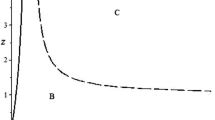Abstract
This paper re-examines environmental regulation, under the assumption that pollution abatement technologies and services are provided by an imperfectly competitive environment industry. It is shown that each regulatory instrument (emission taxes and quotas; design standards; and voluntary agreements) has a specific impact on the price-elasticity of the polluters’ demand for abatement services, hence on the market power of the eco-industry and the resulting cost of abatement. This implies that the optimal pollution tax will be higher than the marginal social cost of pollution, while a voluntary approach to pollution abatement may fail unless the eco-industry itself is willing to participate.
Similar content being viewed by others
References
A. H. Barnett (1980) ArticleTitle“The Pigouvian Tax Rule under Monopoly” American Economic Review 70 1037–1041
S. Barrett (1994) ArticleTitle“Strategic Environmental Policy and International Trade” Journal of Public Economics 54 325–358 Occurrence Handle10.1016/0047-2727(94)90039-6
J. R. Barton (1997) “The North-South Dimension of the Environment and Cleaner Technology Industries” United Nations University Maastricht, The Netherlands
W. J. Baumol (1995) ArticleTitle“Environmental Industries with Substantial Start-Up Costs as Contributors to Trade Competitiveness” Annual Review of Energy and the Environment 20 71–81 Occurrence Handle10.1146/annurev.eg.20.110195.000443
M. Boyer J.-J. Laffont (1999) ArticleTitle“Toward a Political Theory of the Emergence of Environmental Incentive Regulation” Rand Journal of Economics 30 137–157
J. M. Buchanan (1969) ArticleTitle“External Diseconomies, Corrective Taxes, and Market Structure” American Economic Review 59 IssueID1 174–177
O. Cadot B. Sinclair-Desgagné (1995) ArticleTitle“Environmental Standards and Industrial Policy” Journal of Environmental Economics and Management 29 228–237 Occurrence Handle10.1006/jeem.1995.1043
Carraro, C., and G. E. Metcalf. 2001. Behavioral and Distributional Effects of Environmental Policy. NBER Conference Reports, University of Chicago Press.
Davies, S. 2002. “Waste Management Multinationals 2002”. Mimeo, Public Services International research Unit (PSIRU), School of Computing and Mathematical Sciences, University of Greenwich.
European Commission. 1999. “The EU Ecoindustry’s Export Potential: Final Report to DGXI of the European Commission”. Brussels.
H. Farzin P. Kort (2001) ArticleTitle“Pollution Abatement Investment when Environmental Regulation Is Uncertain” Journal of Public Economic Theory 2 IssueID2 183–212 Occurrence Handle10.1111/1097-3923.00036
E. Feess G. Muehlheusser (1999) ArticleTitle“Strategic Environmental Policy, International Trade and the Learning Curve: The Significance of the Environmental Industry” Review of Economics 50 IssueID2 178–194
E. Feess G. Muehlheusser (2002) ArticleTitle“Strategic Environmental Policy, Clean Technologies and the Learning Curve” Environmental and Resource Economics 23 149–166 Occurrence Handle10.1023/A:1021249404533
A. Jaffe R. G. Newell R. N. Stavins (2002) “Technological Change and the Environment” hler Karl-Göran Mä Jeffrey R. Vincent (Eds) Handbook of Environmental Economics Elsevier Science Amsterdam
InstitutionalAuthorNameInstitut Français de l’Environnement (IFEN) (2002) L’environnement en France Éditions La Découverte Paris
Y. Katsoulacos A. Xepapadeas (1995) ArticleTitle“Environmental Policy under Oligopoly with Endogenous Market Structure” Scandinavian Journal of Economics 97 IssueID3 411–420
J. Karliner (1994) ArticleTitle“The Environment Industry: Profiting from Pollution” The Ecologist 24 IssueID2 59–63
Long, N. V., and A. Soubeyran. 1999. “Pollution, Pigouvian Taxes, and Asymmetric International Oligopoly”. CIRANO Working Paper, Montréal.
D. Mookherjee (2003) “Delegation and Contracting Hierarchies: An Overview” Boston University Mimeo
A.-D. Nimubona B. Sinclair-Desgagn é (2005) “The Pigouvian Tax Rule in the Presence of an Eco-Industry” HEC Montréal Mimeo
InstitutionalAuthorNameOrganization for Economic Cooperation and Development (1992) The Environmental Industry in OECD Countries: Situation, Perspectives and Governmental Policies OECD Editions Paris
InstitutionalAuthorNameOrganization for Economic Cooperation and Development. (1996) The Global Environmental Goods and Services Industry OECD Editions Paris
InstitutionalAuthorNameOrganization for Economic Cooperation and Development/Eurostat. (1999) The Environmental and Services Industry: Manual for Data Collection and Analysis OECD Editions Paris
InstitutionalAuthorNameOrganization for Economic Cooperation and Development. (1999) Voluntary Approaches to Environmental Policies: An Assessment OECD Editions Paris
Perry, M. K. 1989. “Vertical Integration: Determinants and Effects”. In Handbook of Industrial Organization, Vol. I, edited by Richard Schmalensee and Robert D. Willig, Amsterdam: North Holland.
A.C. Pigou (1920) The Economics of Welfare Macmillan London
Stavins, R. N. (ed.). 2004. The Political Economy of Environmental Regulation. Edwar Elgar Publishing.
World Trade Organization. 1998. “Environmental Services”. Chapter IX of the Committee on Trade and Environment’s Note on “Environmental Benefits of Removing Trade Restrictions and Distortions”.
Author information
Authors and Affiliations
Corresponding author
Additional information
We thank Dominique Bureau, Olivier Godard, Émeric Henry, Nicolas Marchetti, Alain-Désiré Nimubona, Anne Perrot, Gilles Rotillon, Katheline Schubert, the editors Michael Crew and Anthony Heyes, and two anonymous referees for helpful discussions and suggestions. We also acknowledge valuable comments from seminar audiences at HEC Montréal, the University of Paris I, the University of Toulouse, and the DG-Entreprise of the European Commission in Brussels.
Rights and permissions
About this article
Cite this article
David, M., Sinclair-Desgagné, B. Environmental Regulation and the Eco-Industry. J Regul Econ 28, 141–155 (2005). https://doi.org/10.1007/s11149-005-3106-8
Issue Date:
DOI: https://doi.org/10.1007/s11149-005-3106-8




